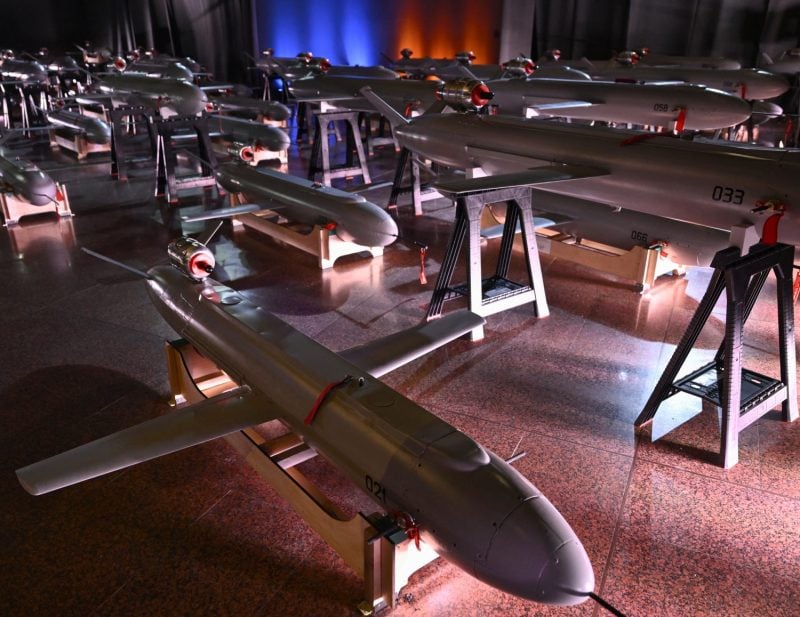The Ukrainians’ New Way of War

The Ukrainians’ New Way of War
The audacious drone attack deep into Russia’s rear fits a larger pattern of wartime innovation.
The first batch of the Ukrainian-made Peklo drone missile is delivered to a Ukrainian Armed Forces facility in Kyiv on Dec. 6, 2024. Genya Savilov/AFP via Getty Images
In the fall of 2022, Kyiv faced a difficult problem. The Russians were bombarding Ukrainian cities with swarms of Iranian Shahed drones. The challenge was spotting them, since their low altitude, small size, and stealthy design made them hard to follow on radar.
A pair of Ukrainian engineers quickly jury-rigged a solution. Today, the country is blanketed with a network of 9,500 microphones mounted on six-foot-tall poles. The microphones, which are attached to cell phones, track the Shaheds by sound (the propeller-driven drones have loud engines) and send that data to a central system that calculates their courses. That information is then passed on to iPad-wielding soldiers in gun trucks that shoot down the slow-moving drones. Each sensor pole in the network costs less than $500—which makes the entire network, known as Sky Fortress, cheaper than a pair of Patriot missiles.
In the fall of 2022, Kyiv faced a difficult problem. The Russians were bombarding Ukrainian cities with swarms of Iranian Shahed drones. The challenge was spotting them, since their low altitude, small size, and stealthy design made them hard to follow on radar.
A pair of Ukrainian engineers quickly jury-rigged a solution. Today, the country is blanketed with a network of 9,500 microphones mounted on six-foot-tall poles. The microphones, which are attached to cell phones, track the Shaheds by sound (the propeller-driven drones have loud engines) and send that data to a central system that calculates their courses. That information is then passed on to iPad-wielding soldiers in gun trucks that shoot down the slow-moving drones. Each sensor pole in the network costs less than $500—which makes the entire network, known as Sky Fortress, cheaper than a pair of Patriot missiles.
I experienced Sky Fortress in action during an extended visit to Kyiv last fall. Shaheds, which sound a lot like lawn mowers in the sky—passed over my apartment building several times. Ukrainian air defenses succeeded in shooting down the majority of them, and they did so at a fraction of the cost of Western-supplied anti-aircraft systems.
All this should explain why I wasn’t entirely surprised when I heard about last weekend’s shrewd Ukrainian drone attack on air bases deep inside Russia. Operation Spiderweb, which appears to have inflicted serious damage on Russia’s strategic bomber fleet, brilliantly exemplifies the Ukrainian way of war, born out of Kyiv’s struggle to survive attacks from an enemy with far larger manpower and resources. This disparity has forced the Ukrainians to get creative, bypass traditional bureaucracies, and empower soldiers and entrepreneurs in the search for unorthodox solutions that quickly address battlefield needs. Since it largely ignores traditional military hierarchy and its slow, top-down processes, one might call Ukraine’s new philosophy “flat war.”
Flat war is less a planned strategy than an organic reflection of Ukraine’s predicament. When Russia launched its full-scale invasion in February 2022, Ukraine’s defense establishment was still dominated by top-heavy, Soviet-style structures. But military and political leaders quickly shifted to a nimbler approach, bringing private companies directly into the process of developing weapons and giving front-line units greater leeway to develop and procure their own systems. In some ways, that shift reflects the country’s recent political history. Decentralization has been a pillar of reform efforts over the past decade or so, which might explain why it has been embraced so thoroughly by soldiers.
One of the most striking traits of the new philosophy is its emphasis on cost-effectiveness. Each of the 117 drones deployed in Operation Spiderweb cost something in the ballpark of $1,000. Kyiv has said that the attack inflicted billions of dollars of damage on Russia, which could well be true given satellite images confirming that around a dozen Russian bombers were destroyed. No matter the actual figure, the cost-benefit calculation skews dramatically in Ukraine’s favor. And the precise number of lost aircraft doesn’t even begin take into account the broader effects on the Russian economy, which is now being thrown into chaos as paranoid security officials stop every truck on the road in search of more drones.
From a Ukrainian perspective, the most unusual thing about Operation Spiderweb is precisely the fact that President Volodymyr Zelensky appears to have been directly involved. Today, many of the most vital warfighting decisions are made not by the president’s office or the Ministry of Defense, but at the brigade level—the fundamental building block of the Ukrainian military. Brigades recruit their own soldiers (whom they can divert to technology development work according to their qualifications), liaise directly with companies about the weapons they need, and even manufacture drones in their own 3D-printing facilities. (Zelensky recently said that Ukraine made 2.2 million drones in 2024; the production target for this year is more than double that.)
In the best cases, the flattening of distance between decision-makers and warfighters promotes rapid innovation. Not many militaries in the world would have had the audacity to field a missile-equipped naval drone of the kind that shot down two Russian fighter jets over the Black Sea last month. Operating outside bureaucratic constraints in the months after Russia launched its invasion, Ukrainian tech experts quickly developed an app that allowed troops, spotters, and artillery units to coordinate attacks. Ukrainians have also made remarkable strides in adapting artificial intelligence systems to the battlefield. Kateryna Bondar, a fellow at the Center for Strategic and International Studies, has outlined how some of the drones in Operation Spiderweb used AI applications to hit their targets.
Speed has become a weapon. “Ukraine’s advantage has not been in the individual technologies it has deployed, but in its ability to regularly outpace Russia in the innovation cycle,” wrote Joyce Hakmeh, deputy director of the international security program at Chatham House, in a recent report. And Hakmeh’s right. Ukraine’s strength hasn’t been in developing clever new gadgets, but in exploiting already available solutions and putting them together in innovative ways. (It was the Ukrainians who were the first to realize that they could put 3D-printed fins on mortar shells and drop them from off-the-shelf consumer drones.)
Ukrainians are constantly adapting to the battlefield. Last year, a friend from Kyiv, who works on the development of naval drones, showed me a spreadsheet tracking all naval drone attacks on Russian targets, and it included vital variables like electronic warfare measures used by the enemy. The data, he explained, was constantly being updated in real time and immediately flowing into the calculations of the drone designers.
My friend was working in conjunction with one of the Ukrainian security services, which operate at the cutting edge of flat war. Granted broad latitude by Zelensky, they have prosecuted an audacious program of covert actions against Russia. The Security Service of Ukraine (SBU), which ran the recent attack on the Russian bases, has made a name for itself with targeted assassinations, such as the December killing of a top Russian general in Moscow, possibly with an exploding scooter. The SBU’s rival, the Ukrainian military intelligence agency (HUR), has been equally aggressive. It was likely behind the 2023 hit on a former Russian submarine commander, who was killed during his morning jog; his assailants had prepared for the attack by hacking into an exercise app that he used. Just hours after Operation Spiderweb left Russian aircraft in flames, HUR announced that its hackers had infiltrated the computer systems of one of Moscow’s leading aircraft designers.
The United States could learn a lot from Ukraine’s flat war, and plenty of people in the U.S. military know it. The Defense Department’s Replicator program, which aims to produce swarms of cheap drones in direct collaboration with private companies, clearly reflects Ukraine’s experience. So, too, is the Pentagon’s Accelerate the Procurement and Fielding of Innovative Technologies initiative, designed to stimulate innovation by detouring around hidebound procurement procedures. Of course, the U.S. defense establishment isn’t going to mimic everything that Ukraine is doing. But a bit more flatness wouldn’t be such a bad thing.
Christian Caryl is the former Moscow bureau chief for Newsweek and U.S. News & World Report. He has reported from more than 60 countries and is the author of Strange Rebels: 1979 and the Birth of the 21st Century. X: @ccaryl
Stories Readers Liked
In Case You Missed It
A selection of paywall-free articles

Four Explanatory Models for Trump’s Chaos
It’s clear that the second Trump administration is aiming for change—not inertia—in U.S. foreign policy.





















Join the Conversation
Commenting is a benefit of a Foreign Policy subscription.
Subscribe
Subscribe
Already a subscriber?
.
View Comments
Join the Conversation
Join the conversation on this and other recent Foreign Policy articles when you subscribe now.
Subscribe
Subscribe
Not your account?
View Comments
Join the Conversation
Please follow our comment guidelines, stay on topic, and be civil, courteous, and respectful of others’ beliefs.
View Comments
Change your username |
Log out
Change your username:
CANCEL
Confirm your username to get started.
The default username below has been generated using the first name and last initial on your FP subscriber account. Usernames may be updated at any time and must not contain inappropriate or offensive language.